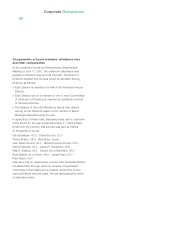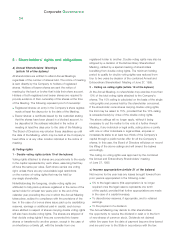APC 2002 Annual Report Download - page 41
Download and view the complete annual report
Please find page 41 of the 2002 APC annual report below. You can navigate through the pages in the report by either clicking on the pages listed below, or by using the keyword search tool below to find specific information within the annual report.
Business review
40
3 - Research and Development
Schneider Electric devoted 472.7 million, or 5.2% of sales,
to research and development in 2002.
As part of its business activities, Schneider Electric uses
patents, brands and trade names belonging to the Company,
or in some cases, licensed by third parties, to manufacture
products, perform services and market its products and
services. In addition, the Company is constantly developing
new technologies, products and processes that it tries to
protect with patents. The Company filed 130 patents in 2002
and more than 121 in 2001. The patents filed during the past
two financial years can be broken down per major category
as follows: 50% electromechanical, 35% electronics and 15%
software.
Given the Company’s current types of products and services,
the Management believes that the business does not
significantly depend on any patent, set of patents or related
licenses.
The Management moreover considers the business not to
depend on a single brand nor on a single trade name. Even
though brands and trade names are closely linked to Company
products and services, and they play a major role in the
marketing of products and services concerned, the
Management finds the risks relating to the diverted or
unauthorized use of its brands and trade names not to be
significant. The Company’s main brands are Merlin Gerin,
Telemecanique and Square D.
Nevertheless, as the product portfolio is expanded through the
addition of new products with extended electronic, computing
and communication functionality, the business will have higher
dependence on intellectual property rights. Consequently, the
risks of counterfeits or of infringement of these rights are likely
to become greater. In addition, the Company holds patents of
a high commercial value, especially in these new technologies.
The Company therefore decided to draw value out of these
intellectual property rights.
4 - Quantitative and Qualitative
Disclosures about Market Risk
The Company’s cash and funds comprise cash provided by
operating activities, revenue from bond and commercial paper
issues, borrowings, and the proceeds from the sale of our
interest in Legrand SA. Thanks to this divestment, we ended
the year with a positive net cash position.
The main borrowings at December 31, 2002 included
three euro-denominated bond issues (1 billion at 3.75%
due in 2004, 450 million at 6.1275% due in 2007 and
a148.3 million perpetual bond issue indexed to the Euribor
+0.7%, due in 2006). We also have various syndicated and
non-syndicated loans totaling 177.1 million, most of which
mature in 2005.
At year-end, outstanding commercial paper issued at fixed
rates and with very short maturities totaled 395 million.
In addition, the Company can draw on confirmed lines
of credit from a number of banks. The unused balance
available at December 31, 2002 amounted to 769 million,
of which 221 million will expire in 2003.
Unit financing and cash management
The Company has implemented a centralized cash pooling and
currency risk management system via wholly-owned subsidiary
Boissière Finance. All operating subsidiaries have access to
this system. Boissière Finance also provides short-term
facilities to certain subsidiaries.
In certain cases, operating subsidiaries have sought and
obtained financing outside our general Group-based financing
system. In particular, Lexel has maintained borrowings that
were contracted before it became part of Schneider Electric.
The confirmed line of credit granted by a banking syndicate in
1997 to finance Lexel’s acquisition of Thorsman was
reimbursed in 2002. Our main North American subsidiary,
Square D Company, has a sale of receivables agreement
under which it sells fractional interests in a pool of eligible
short-term trade receivables, in an amount not to exceed
284 million. Of this, 21 million had been used at
December 31, 2002, leaving a balance of 263 million.
























